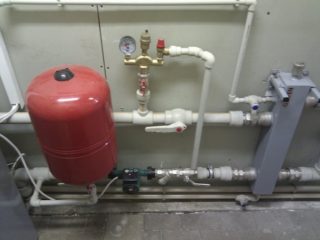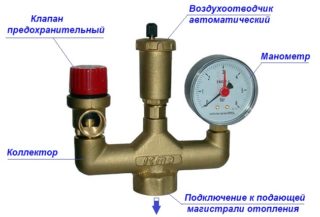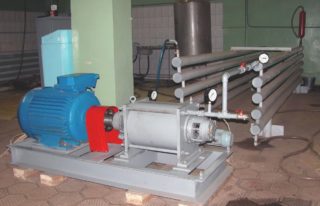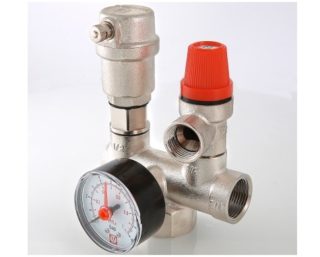The operation of heating units is associated with increased pressure and intense vaporization. Keeping these indicators within acceptable limits is the key to the safe operation of any type of boiler equipment. For these purposes, the heating network has a special set of protective and monitoring devices, including pressure sensors and safety valves.
What is a security group
A safety unit for heating systems means a special set of 3 devices installed in a specific place in a common collector. Its main purpose is to protect heating networks in case of emergency (emergency conditions). In addition, with their help, the user will be able to monitor the current state of the entire system as a whole, including the process of heating the coolant. Their implementation in the form of a single module makes it easier to install in an existing heating network.
The control and safety unit under consideration consists of 3 different devices combined in a common molded case of the collector type. Usually it is made of brass or stainless steel and has 3 seats made in the form of standard threaded connections. In its lower part there is a special coupling that allows you to connect the module to the heating system. Above are the monitoring and safety devices:
- typical pressure gauge for measuring carrier pressure;
- automatic air bleed device;
- relief or safety valve.
Thus, the safety group for heating combines 3 functions at once, which should be dealt with in more detail.
Assigning Group Items
When considering the individual elements of the security node, special attention is paid to their purpose:
- the manometer is designed to control the water pressure in the boiler tank, as well as in the entire system as a whole; its other purpose is to monitor the pressure of the coolant when filling pipelines in closed-type units;
- a device for bleeding excess air allows you to get rid of the so-called "traffic jams" when setting up the heating network; also with its help, portions of steam are produced that are formed in the boiler tank during overheating;
- the safety valve is designed to relieve pressure of water, steam or a mixture thereof when they exceed a predetermined threshold level.
The principle of operation of the safety group of the heating system is to continuously monitor its status and prevent emergency situations. By them is meant the boiling of a heat carrier constantly circulating in the boiler’s water jacket and an excessive increase in pressure in the system, despite the presence of an expansion tank in it.
At the initial stage of deviation from the norm, the manometer registers a noticeable increase in this indicator, after which excess air is discharged through the bleed device. At the last stage, water (steam-water mixture) is discharged by means of a safety valve. In the absence of a boiler safety group, after overheating of the system, an explosion of the unit shell is possible with all the ensuing consequences. If available, the module operates in automatic mode when the relief valve will bleed off the steam until the pressure inside the shell is normal. In most boiler equipment samples, the upper threshold is about 3 Bar.However, there are often models with a maximum working pressure of about 1.6-2.0 bar.
When you can do without GB
A safety group for heating a house is not needed in all situations, since most samples of equipment of the appropriate type already have protection elements. However, at the request of its owner, the installation rules allow the installation of the unit as a safety net.
Heat generators running on natural gas, diesel fuel or electricity are characterized by a high level of safety. Their own safety features built into them are enough to stop the heating of the coolant when an increase in temperature or pressure is detected.
In closed-type apartment systems equipped with gas or electric boilers (boilers), the safety module is usually used for the convenience of monitoring and maintenance. In contrast, units in private houses that run on solid fuel, as a rule, have a significant inertia, and therefore cannot stop instantly. This applies not only to pellet boilers equipped with automatic control systems, but also to devices in which firewood is used as fuel.
In case of violation of the normal operating mode, the built-in thermostat or other control device is triggered immediately, but the process cannot stop immediately. Firewood cannot be extinguished instantly, but will smolder for some time, resulting in a slight increase in water temperature. In this case, the installation of a security group will help prevent an accident in a solid fuel boiler.
Self-assembly instructions
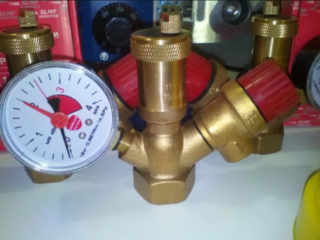
If the wood or coal boiler purchased at the store does not have its own protective unit in the kit, you can buy it separately and then install it on your own equipment. In this case, the main attention is paid not so much to the company producing this combined product as to the correct choice of the devices themselves. Not all safety nodes offered by manufacturers are suitable for a specific model of a heat generator.
As a rule, the characteristics of the air bleed device are not critical and you can ignore this component of the assembly.
In contrast, the pressure gauge and the emergency valve are selected in accordance with the maximum pressure value, the value of which is given in the boiler equipment operating instructions. Just making sure that they are suitable for this sample boiler, you can buy the product and proceed to installation. From a technical point of view, installing a safety group on a heating unit is not particularly difficult. All that is required for this is to stock up on a basic set of locksmith tools. If available, the connection to the heating system is carried out in one of the following ways:
- installation of the purchased module on a fitting that is already on the collector of the operated boiler - in this case, you will need to follow the coincidence of the thread indicated in inches;
- insert of the safety assembly into the supply pipe in the area of its output from the heat generator.
When installing security elements, it is important to remember several points regarding the features of connecting this device.
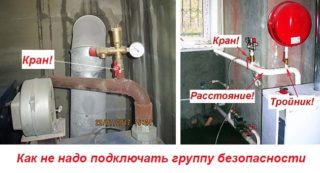 Firstly, according to the requirements of the regulations, it is forbidden to install any types of fittings between the outlet pipe and the safety group, and it is also not allowed to connect other devices via a tee. Secondly, this section itself is made as short as possible (if possible, protective devices are placed close to the boiler body).Thirdly, when the group is mounted on the supply line, a place under it is selected so that the pressure gauge is visible immediately upon entering the boiler room.
Firstly, according to the requirements of the regulations, it is forbidden to install any types of fittings between the outlet pipe and the safety group, and it is also not allowed to connect other devices via a tee. Secondly, this section itself is made as short as possible (if possible, protective devices are placed close to the boiler body).Thirdly, when the group is mounted on the supply line, a place under it is selected so that the pressure gauge is visible immediately upon entering the boiler room.
Sometimes, for better visibility of the instrument panel, the entire group is mounted on a vertical pipe section. As an option - it can be located on a bracket specially equipped for this purpose, fixed on the wall. A transparent hose is connected to the outlet of the safety valve, the other end of which is lowered into a plastic canister or directly into the drain. The first of these discharge schemes is good in that it is convenient to judge by the water level in the tank that the boiler is operating in critical mode.
Groups for boilers from foreign manufacturers
Users of popular imported boilers also have to monitor the functioning of heating equipment. It is precisely for these purposes that a security group is established, which is selected separately for each of its varieties. Such common products of this class as the safety node of the Valtec VT.460.0.0 brand, for example, are on sale. In addition, in the domestic market, models for the Watt KSG 30 boiler of 3 bars, well-known to many users, are widely represented.
The safety fittings from the well-known manufacturer Meibes, whose product catalogs are known all over the world, also belong to the category of fittings for heating equipment that are in high demand.
